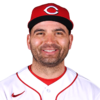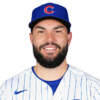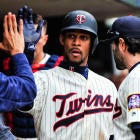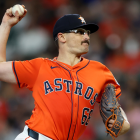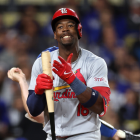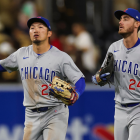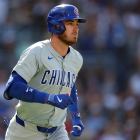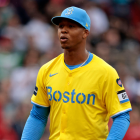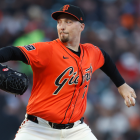When it comes to blockbuster trades, rapid-fire signings, rewarding player performance, and stoking fan interest, the 2017-2018 Hot Stove season was a dud. The hope was that 2018-2019 would be a big bounce-back winter, one that would get seamheads talking all winter long, and cool off the tension and resentment building among players after an offseason of fighting for scraps.
That never happened. Bryce Harper, Manny Machado and dozens of other quality free agents remain unsigned, and now we're left to wonder if the spate of one-year deals happening this winter could make next offseason even worse.
If you're looking for a speck of good news, there's this: Unlike the ice-cold market for player moves, an individual player's performance can turn for the better much more quickly. A strong base set of skills, good health, and a little bit of luck could help some of 2018's biggest disappointments become the darlings of 2019.
We picked four of the biggest 2018 letdown players, and attempted to answer the question: Will these guys be better in 2019, or will the struggles continue?
You can count the number of hitters who would consider numbers 31 percent better than league average as a disappointment on one hand, and Votto would be the middle finger. The Canadian hitting savant still led the National League in on-base percentage, exhibiting his trademark unimpeachable batting eye. But where oh where did the power go? Votto posted the lowest isolated power mark of his career; in bubble-gum card terms, 12 home runs in 623 plate appearances from a first baseman isn't scaring anybody.
Using Statcast's Barrels metric, Votto declined for the third straight season, making less frequent contact with the sweet spot of the bat. The temptation here is to blame injury: He got drilled by a Ryan Madson fastball on Aug. 4, and hit just three home runs over his final 201 plate appearances of the season. But Votto was slugging a mediocre .442 before getting plunked, struggling to drive the ball with the same authority we've seen in the past.
We can look for silver linings, such as Votto posting his lowest groundball rate of any full season in his career. But at age 35, the smart money, sadly, goes against a sudden resurgence in bat speed and power. Still, if your consolation prize is to be prime-years Joe Mauer, that's a sign you're a pretty damn good hitter.
Buxton was everyone's preseason darling heading into last season, coming off a 2017 second half in which he hit a huge .300/.347/.546. Then he hit an endless string of bad beats. First came a debilitating run of migraine headaches. Then Buxton suffered a hairline fracture of his toe. He compounded matters by trying to play through that injury, in the process negating his trademark speed and defense, and hitting a buck-twenty-two to boot.
The Twins sent him down to the minors. Then Buxton missed several weeks with a wrist injury, further delaying any potential return to the bigs. Once finally healthy, Buxton posted a .901 OPS over a 23-game stretch in Triple-A...and still couldn't buy a callup, leading critics to wonder if the Twins might be purposely suppressing his big-league service time.
So really, unless you're ready to declare Buxton a perpetual injury risk and thus a performance risk, you pretty much have to give him a mulligan for that horrific 2018 campaign. It's not clear that the 21 pounds he gained this offseason in an effort to stave off injuries will actually stave off injuries.
The more concerning issue is that Buxton has just that one stellar second half to make his case as a plus hitter at the major-league level. As the fastest player in the league and arguably the most impactful defender at any position, Buxton could be a three-win player even if he can't hit a lick. Given that he's 25, just crossed 1,000 career plate appearances, and has that newfound strength, an offensive breakout could follow. There's just not enough in his profile to predict that it will happen right away.
You want a simple chart? Here's a simple chart -- Dozier's year-by-year home-run totals:
| Year | HR |
|---|---|
2013 | 18 |
2014 | 23 |
2015 | 28 |
2016 | 42 |
2017 | 34 |
2018 | 21 |
It's that 42 number that's thrown us all off. Granted, Dozier's 42-homer outburst doesn't approach the extreme outlier status of, say, Davey Johnson's 1973 season or Brady Anderson's 1996 campaign. But this was the only season of Dozier's career in which he slugged better than .500. The upshot here is simple: Dozier saw a steep drop in batted-ball metrics such as hard-hit rate and barrel rate. The result was a .240 batting average on balls in play that ranked among the worst in the league, and ranked as the worst of his career.
Take the over this season, for two reasons. First, Dozier's supposed off-the-cliff season came from nowhere and happened at the still relatively young age of 31 -- so some positive regression should be expected, because that's just usually how things work following extreme fluctuations in performance. And second, Dozier played through a severe bone bruise in his left knee last season; he still topped 150 games played for the fifth straight season, but he probably would have been better off taking a couple dozen of those off to properly heal.
The free-agent market often overvalues results in the most recent season, while overlooking earlier seasons on a player's resume. The one-year, $9 million deal the Nationals gave Dozier will prove to be a steal. He probably won't go Brady Anderson on the league again, but he should be an upper-tier hitter at a key up-the-middle position.
Eric Hosmer has a groundball problem. It might not be curable.
In 2018, of all the balls Hosmer hit into play, a massive 60.4 percent of them were groundballs -- the second-highest mark in baseball, behind only the Rockies' deeply disappointing rover Ian Desmond. In 2017, that number reached 55.6% percent, fourth-highest in MLB. And in 2016 it was 58.9 percent, second-highest in the majors.
It's not impossible to be a potent hitter while slapping a disproportionately large percentage of balls into the turf. Christian Yelich smacked nearly 52 percent of his balls in play into the ground last season, and walked away with the National League Most Valuable Player award. Hell, Hosmer himself hit a strong .315/.385/.498 in 2017, a line that, along with his playoff experience and a defensive reputation that exceeds what advanced metrics say about him, earned him a gigantic eight-year, $144 million contract from the Padres.
The problem is that Hosmer's 2017 campaign looks like a ($144 million contract-inducing) career year, one boosted by an off-the-charts .351 batting average on balls in play that wasn't supported by any meaningful spikes in hard-hit rates or exit velocity (both those numbers actually fell compared to a year prior).
That flukish 2017 bounce aside, Hosmer is a decent first baseman who has to stretch to clear 20 homers, with OK walk rates and severe worm-burning tendencies. Add in that he's turning 30 this year and is coming off the highest strikeout rate of his career, and we can forecast a modest rebound for Hosmer, but not much more than that.







